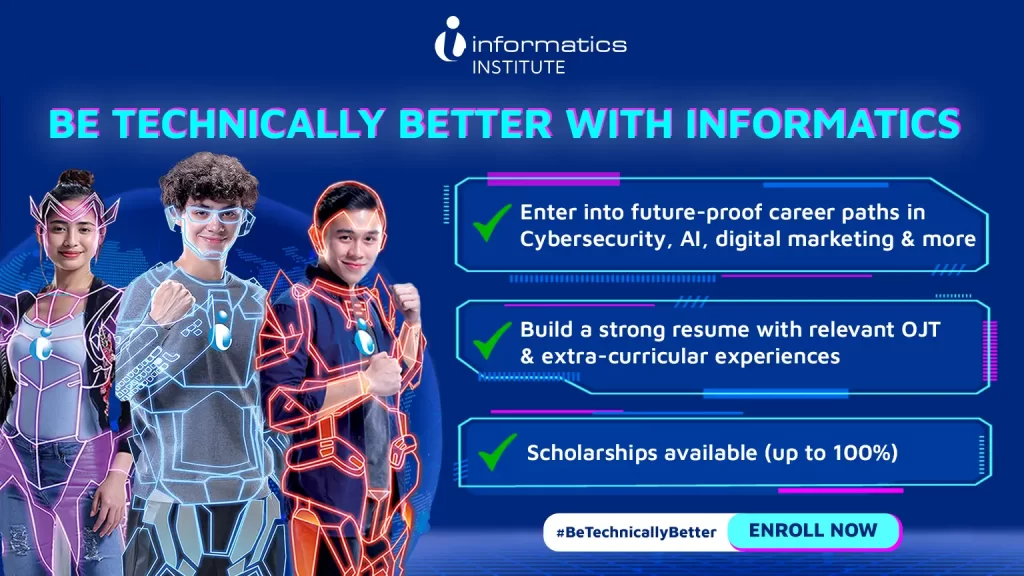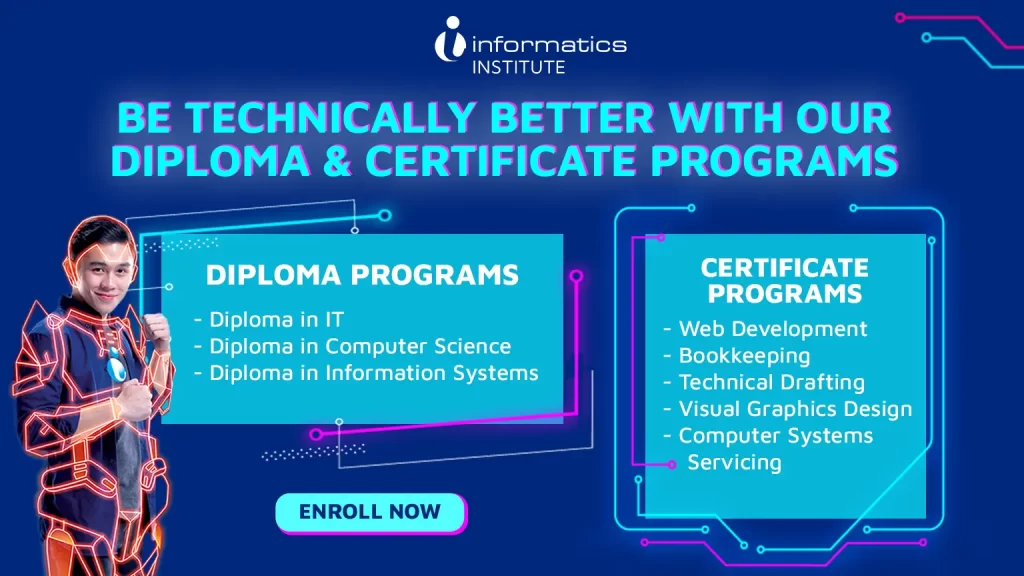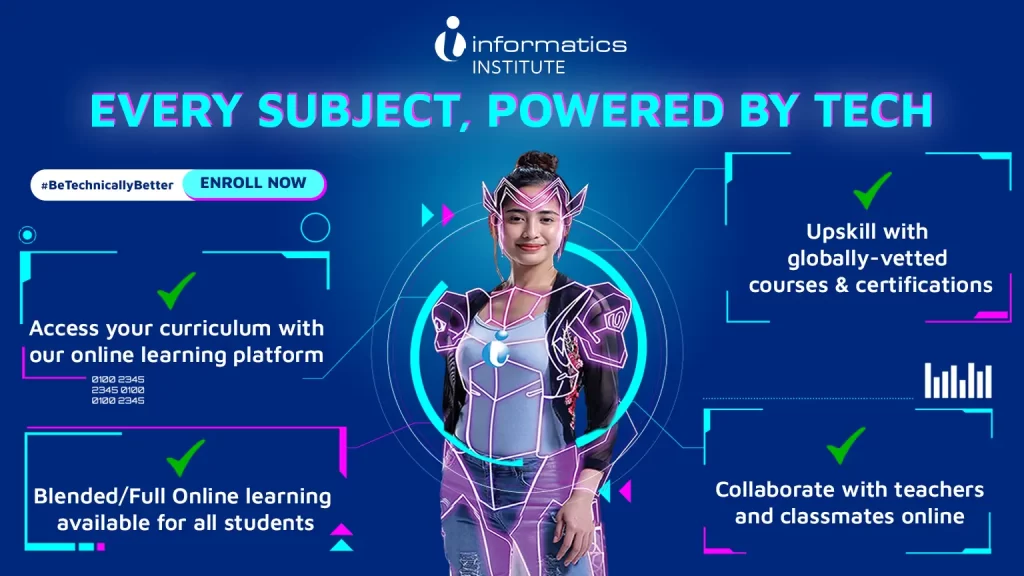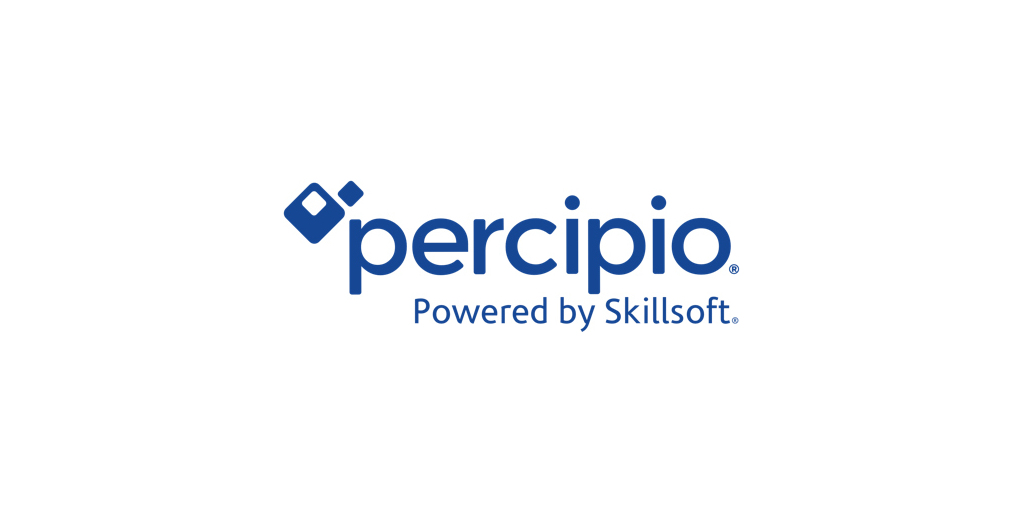
Frequently Asked Questions
About Informatics+, our future-proof learning program
- What is Informatics+?
A flexible and engaging education model, Informatics+ leverages digital education tools, web-based trainings, online and offline learning management systems, use of Artificial Intelligence (AI) and remote and simulated practice labs to provide meaningful learning leading to practical knowledge, skills and abilities among our students. It uses instructional materials that include but are not limited to games, apps, video, audio, and other digital media. This allows Informatics+ to offer a stress-free, more in-depth learning experience that enhances student engagement and satisfaction
Also known generically as personalized-learning, flexible learning and blended learning, Informatics+ enables students to learn at their own pace, anywhere, and anytime, according to their convenience.
- Are blended learning and online learning basically the same thing?
While blended learning typically involves a mix of online and face-to-face instructional strategies, on-line
learning typically does not involve any face-to-face instructional strategies.
- What are the various learning modes available to students under Informatics+?
With Informatics+, the following modalities are available: full online with synchronous and asynchronous classes, face-to-face, blended learning, and self-paced full online modality.
1) Full online classes are delivered
full online without any face-to-face learning classes. These are done synchronously and
asynchronously with fixed schedules for both.
2) Face-to-face or in-person
classes are held particularly for subject areas with as topics that require immediate demonstration after conceptual discussions.
3) Blended learning is a combination
of self-paced online learning and in-person classroom sessions.
4) Self-paced full online modality is for approved petitioned subjects and Professional Electives
where students take their subjects full online without face-to-face sessions, study at their own pace with scheduled consultation sessions with a Mentor.
(NOTE: It is important to have fixed schedules for synchronous and asynchronous classes, online and in-
person for organized room assignments at the center and to avoid conflicting schedules of classes, either
synchronous online or face-to-face. Fixed and predictable schedule will also ensure abiding by the
social/physical distancing set by the IATF Guidelines.)
- What happens during online learning and in-person classroom sessions?
During full online learning, students are actively involved in knowledge acquisition and construction of
their own learning. Students are given login credentials to a digital resource which they can access to
study anytime and anywhere, according to their convenience. On the other hand, during in-person
classroom sessions, students are expected to share insights and clarifications about the concepts
learned during the online learning session.
- Will classes be recorded during synchronous online classes?
Yes. The recorded sessions will be uploaded to ION, Informatics’s Learning Management
System, which will form part of the subject courseware and may be accessed by students
for future reference and review. These recorded sessions will also benefit those who
missed the session.
- What learning materials will be used in this program?
All learning materials will be in digital form. Most are proprietary contents developed by international subject experts. However, there are also materials which are developed by Informatics professional teachers. They also be uploaded in ION as part of the courseware.
- How are learning modalities chosen
per subject?
When you enroll, you will be assigned subjects based on your curriculum and academic
pre- and co-requisites. Learning modalities are dictated by the subject category. Please,
refer to question no. 3.
- How many students are there in a class?
For in-person and synchronous classes, the maximum class size is 40.
- Is Informatics+ proven effective?
- Globally, 61% of students have taken at least one online course or participated in a completely online competency-based program in their life (Dahlstrom et al., 2015, p. 30).
- 57% of students enrolled in an online degree program also visit their physical campus (Best Colleges, 2020, p. 3).
- 65% of faculty worldwide supports open educational sources, which is a less traditional approach (Dahlstrom et al., 2015, p. 31).
- The combination of conventional or traditional learning and modern learning methods using digital learning platforms and tools makes blended learning the ideal learning delivery mode for the post-pandemic era. (University of the Philippines Memorandum on Learning Delivery Modes, 2022).
- One study by Aspden and Helm showed that blended learning improves student engagement by letting them study in their own time and at their own pace. It also allows students to interact with teachers and fellow learners, enhancing their confidence.
- Moreover, the use of digital tools can help educators collect data on student success andprovide guidance and support.
So, yes, it is effective!
- What sets apart Informatics+ from the rest of the schools’ programs?
What sets Informatics+ apart from the rest is the use of time-tested, technology-proven, award winning
learning management tools and digital learning platforms. Aside from that, the design of the program is geared toward students acquiring 21st century skills through authentic, project-based learning. Please, see table for more details.
Informatics+
| Goal | Classroom Learning/Face-to-Face | Blended Learning | Online |
|---|
Teaching and learning activities
between teacher
and students | - learning activities
between teacher
and students - learning activities
between teacher
and students - Individual conferences
- Marked assignments and rubrics
| - Full group lessons
- Small group lessons or tutorials
- Small group lessons or tutorials
- Marked assignments and rubrics
- Digital course materials
- Online discussions
- E-mail
- Instant messages
- News announcements
- Online calendar
- Online calendar
- Rubrics
- Professors of the Practice/ Expert Mentors
| - Digital course materials
- E-mail
- Instant messages
- News announcements
- Online calendar
- Online grade tool
- Rubrics
- Webinars
|
| Collaboration among students | - Learning centers or other room arrangements
- Class discussions
- Face-to-face group work
| - Learning centers or other room arrangements
- Class discussions
- Face-to-face group work
- Online group work
- Online discussions
- E-mail
- Instant messages
- Blogs/Vlogs/Podcast
- Webinars
- Electronic portfolios
| - Online group work
- Online discussions
- Chat sessions
- E-mail
- Instant messages
- Blogs/Vlogs/Podcast
- Electronic portfolios
- Webinars
|
| Demonstration of learning | - Paper-and-pencil tests and assignments submitted in person
- Live presentations, labs, performances, or exhibits of skill
- Models, works of art, posters, and other physical artifacts submitted in person
| - Live presentations, labs, performances, or exhibits of skill
- Online practice labs
- Online assessment with certificates and digital badges
- Models, works of art, posters, and other physical artifacts submitted in person
- Blogs/Vlogs/ Podcast
- Electronic portfolios
- Online discussions
- Online surveys and quizzes
- Assignments, such as essays, worksheets, slide shows, photographs, and videos submitted over ION
| - Online practice labs
- Online assessment with certificates and digital badges
- Online assessment with certificates and digital badges
- Electronic portfolios
- Online discussions
- Online surveys and quizzes
- Assignments, such as essays, worksheets, slide shows, photographs, and videos submitted over ION
- Web conferences
|
| Project-Based Learning (PBL) | PBL is defined as using authentic, real-world projects, based on a highly motivating and engaging questions, task, or problem, to teach students academic content in the context of working cooperatively to solve the problem (Barell, 2007, 2010; Baron, 2011; Grant, 2010)
PBL increases motivation to learn, teamwork, and collaborative skills; hence, recommended for 21st century teaching technique (Partnership for 21st Century Skills, 2004, 2009)
The PBL project covers more than one subject per term leading to more meaningful application of the literacies in each content area or discipline in actual working scenarios. Students will spend less time and resources working on one collaborative project mentored by several of their teachers. Moreover, each project highlights specific skills needed for future work and career.At the end of the project, students are expected to acquire these skills:- Communication skills
- Presentation skills
- Technological skills
- Technological skills
- Independence
- Adaptation
|
Goal
Teaching and learning activities
between teacher
and students
Collaboration among students
Demonstration of learning
Classroom Learning/Face-to-Face
• Full group lessons
• Small group lessons or tutorials
• Individual conferences
• Marked assignments and rubrics
• Full group lessons
• Small group lessons or tutorials
• Individual conferences
• Marked assignments and rubrics
• Paper-and-pencil tests and assignments submitted in person
• Live presentations, labs, performances, or exhibits of skill
• Models, works of art, posters, and other physical artifacts submitted in person
Blended Learning
• Full group lessons
• Small group lessons or tutorials
• Individual conferences
• Marked assignments and rubrics
• Digital course materials
• Online discussions
• E-mail
• Instant messages
• News announcements
• Online calendar
• Online grade tool
• Rubrics
• Professors of the Practice/ Expert Mentors
• Learning centers or other room arrangements
• Class discussions
• Face-to-face group work
• Online group work
• Online discussions
• E-mail
• Instant messages
• Blogs/Vlogs/Podcast
• Webinars
• Electronic portfolios
• Paper-and-pencil tests and assignments submitted in person
• Live presentations, labs, performances, or exhibits of skill
• Online practice labs
• Online assessment with certificates and digital badges
• Models, works of art, posters, and other physical artifacts submitted in person
• Blogs/Vlogs/ Podcast
• Electronic portfolios
• Online discussions
• Online surveys and quizzes
• Assignments, such as essays, worksheets, slide shows, photographs, and videos submitted over ION
Online
• Digital course materials
• Online discussions
• E-mail
• Instant messages
• News announcements
• Online calendar
• Online grade tool
• Rubrics
• Webinars
• Online group work
• Online discussions
• Chat sessions
• E-mail
• Instant messages
• Blogs/Vlogs/Podcast
• Electronic portfolios
• Webinars
• Online practice labs
• Online assessment with certificates and digital badges
• Blogs/Vlogs/Podcast
• Electronic portfolios
• Online discussions
• Online surveys and quizzes
• Assignments, such as essays, worksheets, slide shows, photographs, and videos submitted over ION
• Web conferences
Project-Based Learning (PBL)
PBL is defined as using authentic, real-world projects, based on a highly motivating and engaging questions, task, or problem, to teach students academic content in the context of working cooperatively to solve the problem (Barell, 2007, 2010; Baron, 2011; Grant, 2010)
PBL increases motivation to learn, teamwork, and collaborative skills; hence, recommended for 21st century teaching technique (Partnership for 21st Century Skills, 2004, 2009)
The PBL project covers more than one subject per term leading to more meaningful application of the literacies in each content area or discipline in actual working scenarios. Students will spend less time and resources working on one collaborative project mentored by several of their teachers. Moreover, each project highlights specific skills needed for future work and career.
At the end of the project, students are expected to acquire these skills:
• Communication skills
• Presentation skills
• Technological skills
• Community/Social involvement
• Independence
• Adaptation
- Who Should Take up Informatics+??
Informatics+ is for individuals passionate to gain knowledge for a rewarding experience, who are eager and excited about becoming tech-savvy and highly skilled professionals and future innovators. Being passionate means being focused on the subject and lessons at hand while having fun in learning and collaboration with other like-minded individuals.
- Are all exams and activities taken online?
Except for subjects taken face-to-face, all examinations are conducted online. Academic activities such as assignments may be done online or offline. All submissions will be done online through ION.
- How do I take my online exams?
Examinations are taken online through ION once the student has been issued with a digital exam permit.
- Do online exams have a time limit?
Yes. Time limit depends on the type of examination to be taken.
- What do I do if l lose Internet connectivity while taking the exam?
All students are expected to ensure the stability of Internet connection prior to taking examinations. If Internet connection is unstable prior to taking examinations, students must inform their professors ahead of time. If for some uncontrollable situation occurs that causes Inform your connectivity problem, inform your teacher immediately and discuss how you can continue taking your examination.
- What do I do if my ION account is locked?
You may send an email to _________@informatics.edu.ph to have your ION account unlocked as well as for concerns the use of other platforms related to Informatics+. For other technical concerns, you may also contact ______________ through mobile ________________ or Instant Messenger ________________ for immediate action.
- I don’t have any experience with online and blended learning. Will I be given a seminar, an orientation or a training on the use of the learning systems and tools on Informatics+?
A student orientation will be conducted before start-of-class (SOC) on the use of our platforms, student transactions, school rules and regulations and other important information. Please, feel free to ask questions if there are things which are unclear to you during and even after the orientation. We want you to be ready and to have fun as you journey into your successful future career!
You can also browse the topics below to find what you are looking for.Frequently Asked Questions
Lorem Ipsum
See more questions
Lorem Ipsum
See more questions
Lorem Ipsum
See more questions
What's Happening?
Are you employment-ready? Get real-life skills and work experience through the Informatics+ Blended Learning Program
Are you employment-ready? Get real-life skills and work experience through the Informatics+ Blended Learning Program In its mission to […]
Informatics offers over 8,000 digital courses to upskill employees through global learning platform Skillsoft Percipio
Informatics offers over 8,000 digital courses to upskill employees through global learning platform Skillsoft Percipio In its mission to […]
In-demand Homebased Jobs for Filipinos
Working from home may be a different set-up from the traditional office set-up, but it certainly offers a lot of benefits, especially in the new normal. As people are bound to stay at home most of the time during the pandemic, home-based jobs offer a ray of hope to the economy and the people in need of an alternative livelihood.
If you are looking for a job or you are considering a career shift, home-based jobs are something that you should consider. Working from home gives you location independence, sparing you from the stressful daily commute and allowing you to save more money. It will also give you some flexibility in terms of time management.








